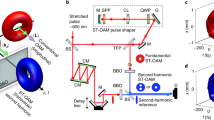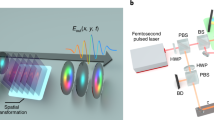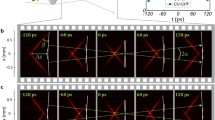Abstract
The synthesis of ultrashort pulses with simultaneously tailored spatial and temporal properties opens new horizons in multimode photonics, especially when the spatial degree of freedom is controlled by robust topological structures. Current methods to shape space–time beams with correlations between their topological charges and spectral components have yielded fascinating phenomena. However, shaping is currently limited to narrow topological and/or spectral bands, greatly constraining the breadth of achievable spatiotemporal dynamics. Here we introduce a Fourier space–time shaper for ultrabroadband pulses, covering nearly 50% of the visible spectrum and carrying a wide range of topological charges with values up to 80. Instead of relying on a conventional grating with linear geometry, our approach employs a diffractive axicon with circular geometry that allows to impart azimuthal phase modulations to beams carrying orbital angular momentum. We retrieve the spatiotemporal field by introducing a characterization technique based on hyperspectral off-axis holography. The tailoring of linear topological–spectral correlations enables the control of several properties of wave packets, including their chirality, orbital radius and number of intertwined helices, whereas complex correlations allow us to manipulate their dynamics. Our space–time beams with broadband topological content will enable a host of novel applications in ultrafast light–matter excitations, microscopy and multiplexing.
This is a preview of subscription content, access via your institution
Access options
Access Nature and 54 other Nature Portfolio journals
Get Nature+, our best-value online-access subscription
$29.99 / 30 days
cancel any time
Subscribe to this journal
Receive 12 print issues and online access
$209.00 per year
only $17.42 per issue
Buy this article
- Purchase on Springer Link
- Instant access to full article PDF
Prices may be subject to local taxes which are calculated during checkout




Similar content being viewed by others
Data availability
The datasets generated during the current study are available from the corresponding authors on reasonable request.
References
Jolly, S. W., Gobert, O. & Quéré, F. Spatio-temporal characterization of ultrashort laser beams: a tutorial. J. Opt. 22, 103501 (2020).
Forbes, A., de Oliveira, M. & Dennis, M. R. Structured light. Nat. Photon. 15, 253–262 (2021).
Divitt, S., Zhu, W., Zhang, C., Lezec, H. J. & Agrawal, A. Ultrafast optical pulse shaping using dielectric metasurfaces. Science 364, 890–894 (2019).
Shen, Y. et al. Roadmap on spatiotemporal light fields. Preprint at https://arxiv.org/abs/2210.11273 (2022).
Yessenov, M., Hall, L. A., Schepler, K. L. & Abouraddy, A. F. Space-time wave packets. Adv. Opt. Photon. 14, 455–570 (2022).
Piccardo, M. et al. Roadmap on multimode light shaping. J. Opt. 24, 013001 (2022).
He, C., Shen, Y. & Forbes, A. Towards higher-dimensional structured light. Light Sci. Appl. 11, 205 (2022).
Wright, L. G., Wu, F. O., Christodoulides, D. N. & Wise, F. W. Physics of highly multimode nonlinear optical systems. Nat. Phys. 18, 1018–1030 (2022).
Kondakci, H. E. & Abouraddy, A. F. Diffraction-free space-time light sheets. Nat. Photon. 11, 733–740 (2017).
Bhaduri, B., Yessenov, M. & Abouraddy, A. F. Anomalous refraction of optical spacetime wave packets. Nat. Photon. 14, 416–421 (2020).
Yessenov, M. et al. Space-time wave packets localized in all dimensions. Nat. Commun. 13, 4573 (2022).
Rego, L. et al. Generation of extreme-ultraviolet beams with time-varying orbital angular momentum. Science 364, eaaw9486 (2019).
Cruz-Delgado, D. et al. Synthesis of ultrafast wavepackets with tailored spatiotemporal properties. Nat. Photon. 16, 686–691 (2022).
Chong, A., Wan, C., Chen, J. & Zhan, Q. Generation of spatiotemporal optical vortices with controllable transverse orbital angular momentum. Nat. Photon. 14, 350–354 (2020).
Wang, H., Guo, C., Jin, W., Song, A. Y. & Fan, S. Engineering arbitrarily oriented spatiotemporal optical vortices using transmission nodal lines. Optica 8, 966–971 (2021).
Chen, W. et al. Time diffraction-free transverse orbital angular momentum beams. Nat. Commun. 13, 4021 (2022).
Pariente, G. & Quéré, F. Spatio-temporal light springs: extended encoding of orbital angular momentum in ultrashort pulses. Opt. Lett. 40, 2037–2040 (2015).
Chen, L. et al. Synthesizing ultrafast optical pulses with arbitrary spatiotemporal control. Sci. Adv. 8, eabq8314 (2022).
Zhao, Z. et al. Dynamic spatiotemporal beams that combine two independent and controllable orbital-angular-momenta using multiple optical-frequency-comb lines. Nat. Commun. 11, 4099 (2020).
Zdagkas, A. et al. Observation of toroidal pulses of light. Nat. Photon. 16, 523–528 (2022).
Wan, C., Cao, Q., Chen, J., Chong, A. & Zhan, Q. Toroidal vortices of light. Nat. Photon. 16, 519–522 (2022).
Wang, J. et al. Terabit free-space data transmission employing orbital angular momentum multiplexing. Nat. Photon. 6, 488–496 (2012).
Mounaix, M. et al. Time reversed optical waves by arbitrary vector spatiotemporal field generation. Nat. Commun. 11, 5813 (2020).
Zou, K. et al. Tunability of space-time wave packet carrying tunable and dynamically changing OAM value. Opt. Lett. 47, 5751–5754 (2022).
Cerullo, G. & De Silvestri, S. Ultrafast optical parametric amplifiers. Rev. Sci. Instrum. 74, 1–18 (2003).
Manzoni, C. & Cerullo, G. Design criteria for ultrafast optical parametric amplifiers. J. Opt. 18, 103501 (2016).
Zavelani-Rossi, M. et al. Pulse compression over a 170-THz bandwidth in the visible by use of only chirped mirrors. Opt. Lett. 26, 1155–1157 (2001).
Perri, A. et al. Hyperspectral imaging with a TWINS birefringent interferometer. Opt. Express 27, 15956–15967 (2019).
McGloin, D. & Dholakia, K. Bessel beams: diffraction in a new light. Contemp. Phys. 46, 15–28 (2005).
Dardikman, G. & Shaked, N. T. Is multiplexed off-axis holography for quantitative phase imaging more spatial bandwidth-efficient than on-axis holography? [Invited]. J. Opt. Soc. Am. A 36, A1–A11 (2019).
Tokizane, Y., Oka, K. & Morita, R. Supercontinuum optical vortex pulse generation without spatial or topological-charge dispersion. Opt. Express 17, 14517–14525 (2009).
Bouchard, F., Mand, H., Mirhosseini, M., Karimi, E. & Boyd, R. W. Achromatic orbital angular momentum generator. New J. Phys. 16, 123006 (2014).
Wakayama, T. et al. Generation of achromatic, uniform-phase, radially polarized beams. Opt. Express 22, 3306–3315 (2014).
Radwell, N., Hawley, R. D., Götte, J. B. & Franke-Arnold, S. Achromatic vector vortex beams from a glass cone. Nat. Commun. 7, 10564 (2016).
Naik, D. N., Saad, N. A., Rao, D. N. & Viswanathan, N. K. Ultrashort vortex from a Gaussian pulse—an achromatic-interferometric approach. Sci. Rep. 7, 2395 (2017).
Berry, M. V. Optical vortices evolving from helicoidal integer and fractional phase steps. J. Opt. A: Pure Appl. Opt. 6, 259 (2004).
Porras, M. A. Attosecond helical pulses. Phys. Rev. A 100, 033826 (2019).
Cuche, E., Bevilacqua, F. & Depeursinge, C. Digital holography for quantitative phase-contrast imaging. Opt. Lett. 24, 291–293 (1999).
Maznev, A. A., Crimmins, T. F. & Nelson, K. A. How to make femtosecond pulses overlap. Opt. Lett. 23, 1378–1380 (1998).
Brida, D., Manzoni, C. & Cerullo, G. Phase-locked pulses for two-dimensional spectroscopy by a birefringent delay line. Opt. Lett. 37, 3027–3029 (2012).
Genco, A. et al. k-Space hyperspectral imaging by a birefringent common-path interferometer. ACS Photonics 9, 3563–3572 (2022).
Gabolde, P. & Trebino, R. Self-referenced measurement of the complete electric field of ultrashort pulses. Opt. Express 12, 4423–4429 (2004).
Pinnell, J. et al. Modal analysis of structured light with spatial light modulators: a practical tutorial. J. Opt. Soc. Am. A 37, C146–C160 (2020).
Béjot, P. & Kibler, B. Spatiotemporal helicon wavepackets. ACS Photonics 8, 2345–2354 (2021).
Béjot, P. & Kibler, B. Quadrics for structuring invariant space-time wavepackets. ACS Photonics 9, 2066–2072 (2022).
Gutiérrez-Vega, J. C., Iturbe-Castillo, M. & Chávez-Cerda, S. Alternative formulation for invariant optical fields: Mathieu beams. Opt. Lett. 25, 1493–1495 (2000).
Bandres, M. A. Accelerating parabolic beams. Opt. Lett. 33, 1678–1680 (2008).
Miranda, M. et al. Spatiotemporal characterization of ultrashort laser pulses using spatially resolved Fourier transform spectrometry. Opt. Lett. 39, 5142–5145 (2014).
Pariente, G., Gallet, V., Borot, A., Gobert, O. & Quéré, F. Space-time characterization of ultra-intense femtosecond laser beams. Nat. Photon. 10, 547–553 (2016).
Borot, A. & Quéré, F. Spatio-spectral metrology at focus of ultrashort lasers: a phase-retrieval approach. Opt. Express 26, 26444–26461 (2018).
Jolly, S. W., Gobert, O. & Quéré, F. Spatio-spectral characterization of ultrashort laser pulses with a birefringent delay line. OSA Continuum 4, 2044–2051 (2021).
Alonso, B. et al. Complete spatiotemporal and polarization characterization of ultrafast vector beams. Commun. Phys. 3, 151 (2020).
Yessenov, M., Chen, Z., Lavery, M. P. J. & Abouraddy, A. F. Vector space-time wave packets. Opt. Lett. 47, 4131–4134 (2022).
Vieira, J., Mendonça, J. T. & Quéré, F. Optical control of the topology of laser-plasma accelerators. Phys. Rev. Lett. 121, 054801 (2018).
Willner, A. E. et al. Perspectives on advances in high-capacity, free-space communications using multiplexing of orbital-angular-momentum beams. APL Photonics 6, 030901 (2021).
Pinnell, J., Rodríguez-Fajardo, V. & Forbes, A. How perfect are perfect vortex beams? Opt. Lett. 44, 5614–5617 (2019).
Harth, A. et al. Compact 200 kHz HHG source driven by a few-cycle OPCPA. J. Opt. 20, 014007 (2018).
Acknowledgements
This work has been financially supported by the European Research Council (ERC) under the European Union’s Horizon 2020 research and innovation programme ‘METAmorphoses’, grant agreement no. 817794. This work has been supported by Fondazione Cariplo, grant no. 2019-3923. This publication is part of the METAFAST project that received funding from the European Union Horizon 2020 Research and Innovation programme under grant agreement no. 899673. This work reflects only the authors’ view and the European Commission is not responsible for any use that may be made of the information it contains.
Author information
Authors and Affiliations
Contributions
M.P. conceived the original idea. M.P., M.O., V.R.P., M.R., G.V., C.M., G.C. and A.A. designed the experiments. M.P., M.O., V.R.P., M.R., B.A. and M.C. performed the measurements. M.P. and J.V. performed the theory and simulations. M.P. and M.O. fabricated the devices. M.P., V.R.P., B.A., M.C. and C.M. analysed the experimental data. All authors contributed to the interpretation of results and to the writing of the manuscript.
Corresponding authors
Ethics declarations
Competing interests
The authors declare no competing interests.
Peer review
Peer review information
Nature Photonics thanks Pierre Bejot, Spencer Jolly and the other, anonymous, reviewer(s) for their contribution to the peer review of this work.
Additional information
Publisher’s note Springer Nature remains neutral with regard to jurisdictional claims in published maps and institutional affiliations.
Extended data
Extended Data Fig. 1 Isosurfaces in 3D space of a helical wave packet synthesized experimentally.
The corresponding topological-spectral correlation of this beam is shown in Fig. 2e. Here, the temporal coordinate is replaced by the z-propagation coordinate, as we obtain from hyperspectral off-axis holography the space-time beam propagation at different times: a, t = 0; b, t = 67 fs, corresponding to a beam propagation of 20 μm; c, t = 167 ps, corresponding to a beam propagation of 5 cm. Apart from a very small lateral shift, the beam essentially translates along the z-axis as it propagates (in the direction marked by the red arrow in a). Due to its helical structure, at a given z-plane the space-time beam appears as a pulse that rotates over time on a circular trajectory, as shown in the space-time isosurface of Fig. 2f. The isosurfaces are defined at 10% of the intensity peak.
Extended Data Fig. 2 Additional linear and complex topological-spectral correlations.
a, Linear correlation with OAM spanning from ℓ = 10 to 30 corresponding to a helical wave packet with small orbital radius. b, Three intertwined helices obtained by employing discrete steps with δℓ = 3 in the correlation. c, Parabolic correlation with broadband OAM content spanning from ℓ = 5 to 90. d, Sinusoidal correlation completing two full oscillations over the spectral bandwidth. Due to the symmetry of the sinusoidal function, the reconstructed intensity does not show oscillations, analogously to the achiral wave packet obtained from parabolic correlations in Fig. 4d. Each panel shows the intensity of the electric field at t = 0 (top left), the time-averaged color image of the beam obtained by an hyperspectral camera (bottom left), the iso-surface at 10% of the intensity peak (center), and the experimental correlation (right). The size of the intensity and color images is 4 mm.
Extended Data Fig. 3 Chirality and number of intertwined helices obtained from the analytical theory.
δℓ is a parameter in our analytical theory of helical wave packets with linear topological-spectral correlations corresponding to the discrete step in OAM value between two neighboring spectral windows. Cylinders represent the 2D space defined by the azimuthal angle and time variable, and on their surfaces we plot the intensity of the wave packet from equation S12 of Supplementary Note 7. a,b, By changing the sign of δℓ, the chirality of the helical wave packet changes. b–d By increasing the magnitude of δℓ, the number of intertwined helices increases correspondingly.
Extended Data Fig. 4 Simulated and measured orbital period of a wave packet synthesized from a square root correlation function.
a, Correlations obtained from equation (1) using p = 0.5 (red) and, for comparison, p = 1 (yellow). The other parameters of the equation are Δℓ = 30, ℓ1 = 40, Δω/2π = 137 THz, ω2/2π = 566 THz. b, Experimental square root correlation function. c Azimuthal position of the maximum of the rotating pulse as a function of time obtained from the simulations using p = 0.5 (red) or p = 1 (yellow). By fitting the slopes corresponding to the angular velocity Ω we obtain the orbital periods Torb = 2π/Ω reported in the plots, indicating that the complex correlation function produces a shorter Torb and a larger Ω. The inset shows how the azimuthal position is extracted at a given time from the maximum of the rotating space-time beam intensity. The simulation assumes a frequency chirp in the input beam equivalent to a group delay dispersion of 79 fs2, as the one measured experimentally using hyperspectral holography. d Azimuthal position as a function of time obtained from the experimental space-time beam synthesized using the square root correlation function, giving a value close to the simulated one for p = 0.5.
Extended Data Fig. 5 Spectrally-resolved beam profiler images of the NOPA beam measured with TWINS.
a, RGB image of the NOPA beam at the output of the parametric amplifier. The spectrum measured on the left side of the beam has a weaker component in the green region as compared to the right side of the beam, corresponding to a small spatial chirp on the beam, in the sense that the spatial intensity profile has a slight frequency dependence. b–g, Spectral images of the beam for a selected set of wavelengths ranging from 710 nm to 523 nm obtained using the hyperspectral measurement technique. The size of all images is 11.2 mm × 7.0 mm.
Extended Data Fig. 6 Generation of OAM-carrying Bessel-Gauss or Laguerre-Gauss beams by a single or double pass through axicons in our system.
The numerical simulations assume an input Gaussian beam with 500 nm wavelength entering the setup. The phase plate imparting OAM in the far field of the axicon has a charge ℓ = 10. a, Setup schematic for OAM-carrying Bessel-Gauss beam generation. The detection plane (vertical dashed line) is slightly shifted from the 4f plane to allow for the formation of the Bessel-Gauss beam (as in Supplementary Fig. S4a). b,c, Simulated intensity and phase of the beam at the detection plane showing a Bessel-Gauss beam with ℓ = 10. d, Setup schematic for OAM-carrying Laguerre-Gauss beam generation. In this case a second negative axicon being the conjugate of the first positive axicon is placed at 4f. The detection plane is at 2f from the second axicon. e, Due to the their complementary grating shapes, the phase contributions of the two axicons cancel out in this arrangement. f,g, Simulated intensity and phase of the beam at the detection plane showing a Laguerre-Gauss beam with ℓ = 10. In a and d the 4f imaging systems are shown unfolded for clarity and using lenses, though they can be implemented with a single spherical mirror as in Fig. 2a. An amplitude mask is used to block the zero order in the far field of the axicon.
Supplementary information
Supplementary Information
Supplementary Notes 1–7 and Figs. 1–11.
Supplementary Video
Animations and volumetric visualizations.
Rights and permissions
Springer Nature or its licensor (e.g. a society or other partner) holds exclusive rights to this article under a publishing agreement with the author(s) or other rightsholder(s); author self-archiving of the accepted manuscript version of this article is solely governed by the terms of such publishing agreement and applicable law.
About this article
Cite this article
Piccardo, M., de Oliveira, M., Policht, V.R. et al. Broadband control of topological–spectral correlations in space–time beams. Nat. Photon. 17, 822–828 (2023). https://doi.org/10.1038/s41566-023-01223-y
Received:
Accepted:
Published:
Issue Date:
DOI: https://doi.org/10.1038/s41566-023-01223-y
This article is cited by
-
Direct space–time manipulation mechanism for spatio-temporal coupling of ultrafast light field
Nature Communications (2024)
-
Integrated vortex soliton microcombs
Nature Photonics (2024)
-
Integrated optical vortex microcomb
Nature Photonics (2024)
-
Ultrashort coils of light
Nature Photonics (2023)



